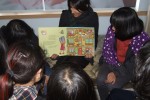What to Focus on in ESL Reading Exercises


Replicating the Elements of Natural Language Acquisition
The problem with this approach is that it fails to convey many of the elements of natural language acquisition. Babies and toddlers learning their first languages do so through exposure to the entirety of the language as commonly used by the older people around them. Excluding times where there parents or caretakers may set aside to devote concentration specifically to simple words and sounds, these budding minds are thrown into the chaos of fully-developed adult human language from day one.
Many of the leading linguistic experts agree that the factors of childhood language acquisition should be, to a degree, replicated by adult ESL learners. This is especially pertinent when teachers move beyond basic definitions and into more complex ESL reading exercises. The goal of ESL reading exercises should not be to teach the student just how to say particular words. After all, don’t you discover new English words all the time you can’t necessarily pronounce right away? Don’t you infer the meanings from context and etymology, even as a native English speaker?
Reading with Tone, Inflection, and Emotion
One of the hardest things about learning a new language is actually just recognizing the natural changes in tone, pitch, and inflection a person displays when they speak for any extended length of time. This is the point where language transcends from merely a word-for-word exchange of data and information into a powerful display of emotion and character. It’s also one of the hardest things to teach- as it requires numerous live displays from a clearly emotive and outspoken teacher.
When your students read to you, forget about focusing with excruciating detail on every word or syllable uttered. Start by getting them to look at groups of three or four words at a time instead of maintaining the tunnel-vision they are probably comfortable with. When they start to master that, move up to clauses or complete sentences. Show them with your own voice how proper punctuation provides important cues for when to include pauses in speech and change tone.
Lead Reading Exercises by Example
Give them plenty of demonstrations to remember and draw upon for expressing various human emotions. The tones of voice you are accustomed to associating with happiness, anger, frustration, joy, sorrow, and surprise might not even exist in other languages. For this reason, a great ESL teacher often needs to evolve into the role of a great actor and public speaker during ESL reading exercises. You’re no longer training your rote memorization of direct translation or image association; you’re now training them in new fundamental ranges of self-expression. It’s a more difficult and advanced educational process than just memorizing words and phrases, but the results are amazing for ESL students at any age.
Click here for more ESL reading tips by Reach To Teach.
Tom Fitton is currently working for LAL Schools, providing advice for ESL learners and helping other language students to pick up techniques to improve their learning.




